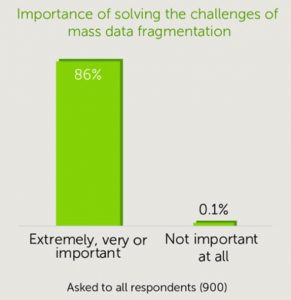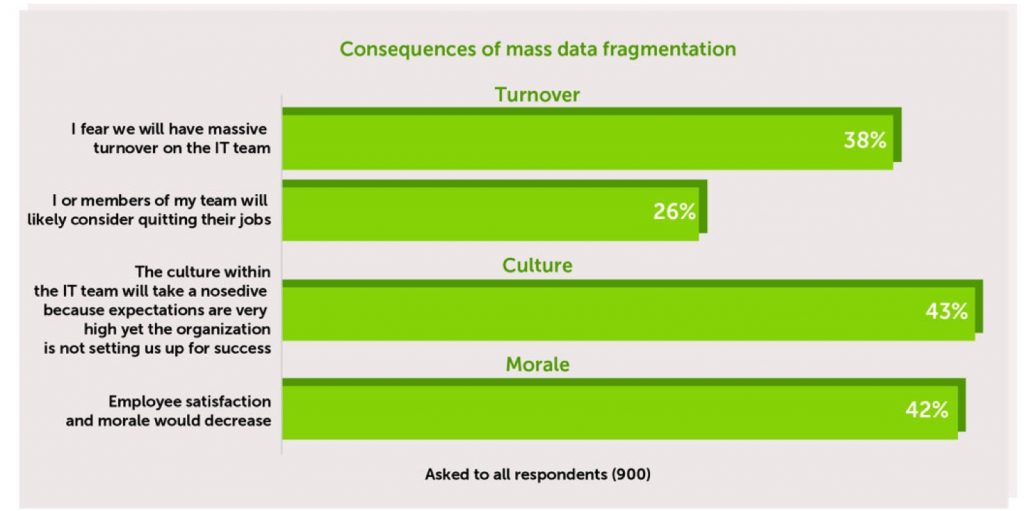Mass Data Fragmentation – Cohesity/Vanson Bourne
86% of IT decision makers believe it's important to solve.
This is a Press Release edited by StorageNewsletter.com on December 5, 2018 at 2:13 pmCohesity, Inc., in hyperconverged secondary storage, announced the results of a survey that validates a critical problem plaguing enterprises around the world: mass data fragmentation.
The survey of more than 900 senior IT decision makers revealed that 87% believe their organization’s secondary data is fragmented across silos and is, or will become, nearly impossible to manage long-term, which could have devastating consequences. Respondents cited growing fears around competitive threats, compliance risks, job losses, sinking morale, and missed opportunities to increase revenue by as much as 10%.
Mass data fragmentation refers to the growing proliferation of data spread across a myriad of different locations, infrastructure silos, and management systems that prevents organizations from fully utilizing its value.
The survey, commissioned by Cohesity and conducted by Vanson Bourne, found that 86% of decision makers believe it’s important, very important, or extremely important to solve the challenges of mass data fragmentation.
Respondents are employed by enterprises in USA, UK, France, Germany, Australia, and Japan, across a variety of industries including financial services, healthcare, life sciences, media and entertainment, technology, and the public sector. The companies represented in the survey had average revenue of $10.5 billion.

“IT leaders globally are wrestling with mass data fragmentation and the snowball effect caused by this critical infrastructure challenge,” said Mohit Aron, CEO and founder, Cohesity. “Data silos create compute and management silos, and it becomes nearly impossible for organizations to solve this constantly growing problem. Data becomes a burden when it really should serve as a competitive asset.”
What Is Driving Mass Data Fragmentation?
The results show there are several core issues accelerating mass data fragmentation challenges.
• Data is massively siloed: There is fragmentation across and within silos. This problem is exacerbated by the sheer volume of point products used to manage secondary workloads such as backups, file shares, object stores, test and development, and analytics.
- 35% of respondents reported using six or more different solutions to manage all of their secondary data operations. More than 10% of organizations use 11 or more solutions.
• Data copies are multiplying: There are copies of the same data everywhere because point products don’t allow data sharing or reuse.
- 63% of organizations have 4-15 copies of the same data.
• Data is spread across multiple locations: Data sprawl is happening on-premises and in the cloud, adding even more management complexity.
- 85% of respondents store data in two to five public clouds, and that includes
- 16% that store data in four or more public clouds.
Among organizations that store data in public cloud, 74% report making an alternate or redundant copy of that data, storing it in either the same public cloud or another public cloud, adding even more data copies to oversee.
Mass data fragmentation has the potential to wreak havoc on IT teams and budgets that are already spread thin. The overwhelming majority of respondents believe it will take their IT teams more time to manage secondary apps and data – on average 31% more time, or an additional 16 weeks each year – if proper tools aren’t in place. And for those who believe their organization’s secondary data is fragmented, more than half fear they will exceed their IT budget due to spending on unnecessary storage.
Concerns About Compliance, Competitiveness, and Employee Well-Being
The survey also uncovered serious risks that mass data fragmentation poses to organizations.
Compliance risks and competitive challenges:
• At a time when compliance regulations are front of mind for organizations, 91% of respondents said they were concerned about the level of visibility that the IT team has into secondary data across all sites.
• Of those who feel that their organization’s secondary data is fragmented across different silos of infrastructure:
- 49% believe that failing to address mass data fragmentation will put their organization at a competitive disadvantage.
- 47% said customer experience would suffer because fragmentation would make it impossible for their organizations to glean insights from secondary data.
Employee well-being:
If IT is expected to manage all of the organization’s secondary data and apps without proper technology:
• 38% fear massive turnover on the IT team, and 26% said that they or someone on their team would consider quitting.
• 43% believe culture within the IT team will take a nosedive because expectations are out of whack and the organization is not set up for success.
• 42% said employee satisfaction and morale would suffer.
Click to enlarge
Solving Mass Data Fragmentation Unlocks Significant Rewards
91% of senior IT decision makers said that if half of the IT resources their organization spends managing secondary data were redeployed to more business-critical IT actions, it could have a positive impact on the company’s revenues over a five-year period.
• Nearly 30% of respondents believe this adjustment in IT resources could increase revenues by at least 6% over a five-year period. And, 9% say revenue could increase by 8-10% or more.
• With average revenue of companies above $10 billion, an 8-10% increase would translate to roughly $800 million to $1 billion in new revenue opportunities.
Complete market study from Vanson Bourne (registration required)













 Subscribe to our free daily newsletter
Subscribe to our free daily newsletter
